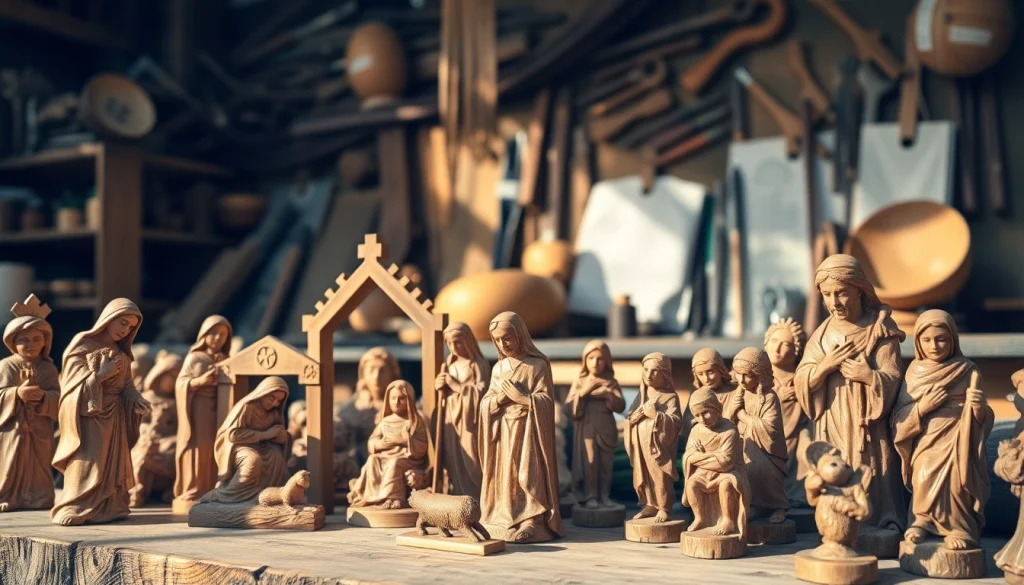
Introduction to Olive Wood Carvings
Olive wood carvings are much more than mere decorative items; they symbolize rich spiritual heritage and artistic tradition, particularly within the context of the Holy Land. Through the intricate artistry of local artisans, olive wood has been transformed into stunning pieces that resonate with history and faith. For those looking to explore the unique charm of olive wood carvings, this article delves into their significance, craftsmanship, and the multitude of options available.
What are Olive Wood Carvings?
Olive wood carvings encompass a variety of decorative and functional objects created from the hardwood of the olive tree. Items can range from religious figures and crosses to artistic sculptures and everyday utility objects. The distinct grain and rich color of olive wood lend an unparalleled aesthetic, making each carving unique. Traditionally, these carvings hold spiritual significance and are often used in religious rituals, making them revered both as functional objects and as art pieces.
Origins and Cultural Significance
The tradition of olive wood carving is deeply rooted in the cultural and religious narratives of the Middle East, particularly in Bethlehem and Jerusalem. The olive tree itself is emblematic of peace and resilience, often finding mention in various religious texts. Artisans from this region have inherited the craft from generations, with skills and techniques passed down allowing them to create pieces that reflect the rich tapestry of their history. Olive wood carvings not only serve as works of art but also as spiritual reminders, connecting individuals to their faith and ancestral heritage.
Materials and Techniques Used
Olive wood itself is prized for its tight grain, which makes it sturdier than other types of wood, allowing for intricate carvings that stand the test of time. Artisans select wood from old and gnarled olive trees, which ensures that each piece has unique characteristics. The carving process can involve various techniques, including chiseling and sanding, and often requires specialized tools. Artisans may use hand chisels, knives, and other tools to bring their visions to life, ensuring that each carving embodies precision and attention to detail.
Types of Olive Wood Carvings
Religious and Spiritual Figures
Religious items constitute a significant category of olive wood carvings. Figures depicting saints, angels, and scenes from the Bible are among the favorites, particularly for collectors and those looking to enhance their spiritual practices. Nativity scenes crafted from olive wood are particularly popular at Christmas, symbolizing the birthplace of Jesus and the humble origins of Christianity. These pieces serve not only as decorations but also as focal points for contemplation and devotion.
Home Decor and Utility Items
Beyond spiritual significance, olive wood carvings have found substantial appeal in home decor. Items such as bowls, plates, and serving utensils, crafted from olive wood, combine functionality with art. The natural beauty of the wood enhances any setting while providing durable and sustainably sourced home goods. These items can serve dual purposes, allowing owners to enjoy their aesthetic beauty while also utilizing them in everyday life.
Artistic Sculptures and Collectibles
For art enthusiasts, olive wood sculptures represent an essential addition to any collection. Artists often create abstract forms, wildlife representations, and thematic pieces that reflect cultural narratives or personal expression. Each sculpture tells a story, often representing a unique aspect of life in the Holy Land. Collecting these pieces not only enriches one’s home but also supports artisans keeping this age-old craft alive.
The Craftsmanship Behind Olive Wood Carvings
Hand-Carving Techniques
Hand-carving is the cornerstone of the olive wood craft, requiring immense skill and patience. Artisans begin with a block of olive wood, selecting the grain and character that best suits the intended design. The carving involves shaping the wood using various hand tools, allowing for refined details that machines cannot replicate. The process is labor-intensive and can take days or even weeks, depending on the complexity of the piece. The result is a handcrafted item that exudes personality and artistic flair.
Tools and Equipment
Crafting olive wood carvings involves several traditional tools. Basic equipment includes chisels of varying sizes, knives for detailing, gouges for deeper cuts, and sanding tools for finishing. Each tool has a specific purpose, allowing the artisan to excavate wood carefully, create textures, and ensure the piece is smooth to the touch. Continued innovation and adaptation of tools ensure that artisans can achieve both traditional techniques and modern artistic expressions.
Artisans of the Holy Land
The artisans who create olive wood carvings are often community members who have spent years honing their craft. Many have familial connections to the tradition, learning the skill from parents or grandparents. This generational passage of knowledge fosters a deep appreciation for the culture and enhances the artistry present in each carving. These artisans are not only skilled craftsmen but also storytellers, embedding cultural narratives into each piece.
Buying and Caring for Olive Wood Carvings
Where to Purchase Quality Carvings
Quality olive wood carvings can be found at various outlets, including specialized shops, online retailers, and artisan markets in the Holy Land. It’s essential to choose reputable sellers who provide authentic creations rather than mass-produced alternatives. Many online stores feature collections from artisans in Bethlehem and Jerusalem, ensuring that buyers can obtain genuine pieces that carry the spirit of their origin.
Caring for Your Olive Wood Items
To maintain the beauty and longevity of olive wood carvings, proper care is necessary. Regular cleaning with a soft, damp cloth can help preserve the surface without scratching. It’s advisable to avoid harsh chemicals or soaking the wood in water, as this can lead to damage. Instead, occasional treatments with food-safe mineral oil can help restore the wood’s natural shine and keep it moisturized, ensuring that the carvings age beautifully over time.
Signs of Authenticity and Quality
When purchasing olive wood carvings, look for signs of quality craftsmanship. Authentic pieces often exhibit intricate details and smooth finishes. The grain of the wood should be visible and unique to each item. In addition, reputable sellers typically provide certification of authenticity, which is essential in distinguishing genuine handcrafted pieces from cheaper, mass-produced alternatives. Understanding these indicators can enhance the buyer’s confidence in their purchases.
Olive Wood Carvings as Gifts and Collectibles
Gift Ideas for Different Occasions
Olive wood carvings make thoughtful gifts for various occasions. Religious figures are perfect for baptisms or confirmations, while home decor items such as bowls and crosses are ideal for housewarmings or weddings. Each piece carries a story, often making the gift more meaningful by inviting the recipient to connect with the traditions and artistry of the Holy Land. Selecting a personalized item, such as an engraved piece, can add an additional layer of thoughtfulness.
Cultural Value as Collectibles
Collecting olive wood carvings provides insights into the rich cultural heritage of the Holy Land. Here, each piece reflects the identity, faith, and artistry of the artisans who created them. Collectors often seek out limited-edition pieces or those that feature unique techniques, connecting themselves to the craft on a deeper level. As upholding traditional skills becomes increasingly important, investing in these collectibles contributes to preserving this artisan culture.
Personalizing Your Olive Wood Gifts
Personalization adds a special touch to olive wood gifts, setting them apart from standard offerings. Options for personalization include engraving names, dates, or meaningful phrases into the wood. Many artisans are open to custom requests, allowing for the creation of unique pieces that resonate with the giver and recipient. This not only enhances the aesthetic appeal but also creates lasting memories tied to the gift.
Conclusion
Olive wood carvings are a beautiful intersection of artistry, craftsmanship, and cultural significance. From religious icons to home decor, these timeless pieces resonate not only as stunning artifacts but also as vessels of rich traditions. Understanding the various aspects involved in their creation, care, and value can guide enthusiasts and collectors in fully appreciating each piece’s history and artistry. Whether for personal use, home decoration, or as a heartfelt gift, olive wood carvings continue to enrich lives and celebrate the enduring spirit of the artisans who craft them.





